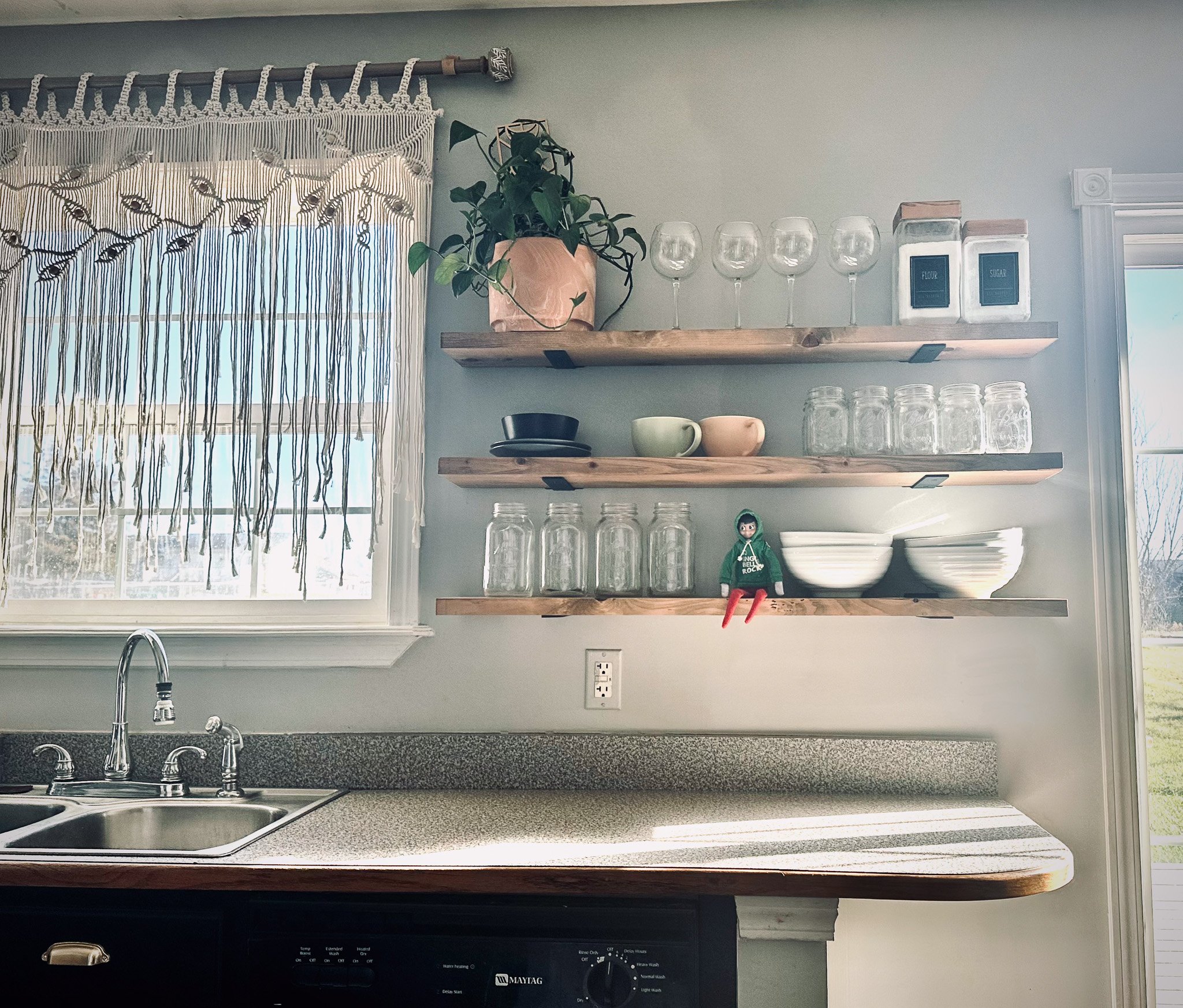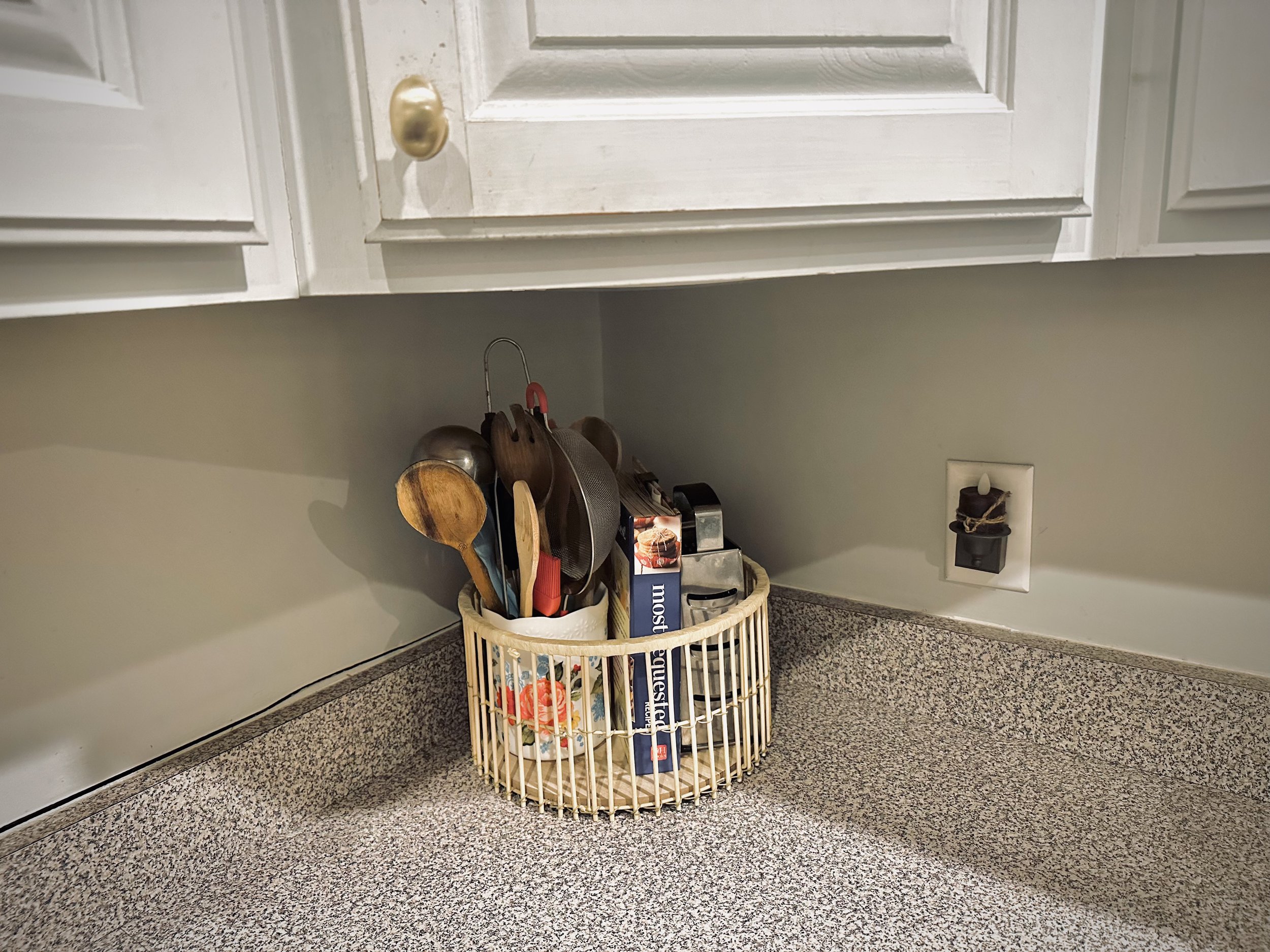Design with Intention
Do you have a folder somewhere of all the social media inspo-photos of beautifully designed spaces that are exactly the feel you’re going for? When you come across a space you love, I encourage you to consider how you live in the same space within your own home. It is often that while inspirational design photos are aesthetically beautiful, they can sometimes feel unattainable for a home that supports a busy lifestyle or a large family with a lot of stuff. Perhaps the kitchen countertop is completely free from appliances and dishes, the couch pillows are perfectly placed without a wrinkle, and there’s not a single shoe sitting by the door (what!? how!?). Many of us fall into the trap of designing spaces based on Pinterest boards and Instagram feeds without considering how we actually live in our homes. But there is a way to make your lived-in home, with all of it’s moving pieces, look and feel like the luxurious spaces you’re inspired by.
Designing with intention is an approach to interior design that focuses on how a space is actually used by the homeowner. It is all about creating a space that is tailored to the needs of the individual or family living in it. This approach can be used to create a home that is functional, comfortable, and reflective of the homeowner’s personal style. This is how you create spaces that you want to be in.
The first step in designing with intention is to really think about how the space is used. Consider the activities you participate in regularly and how your family shares the space. For example, a space may be best used as a playroom or for doing homework in a home with children. In contrast, a couple with no children may prefer to use extra space for entertaining guests. Ask yourself, what do you do in this room? Do you host game night? You may need storage and extra seating. Do you watch a lot of movies? Perhaps you might consider a wall mount tv, more comfortable seating, or filling an empty corner with a cute popcorn stand. Start by considering the general use of each room, and then move to more specific areas. In our home, it is common practice that we take our shoes off as soon as we enter the living room through the garage door. Having a pile of shoes right by the door drove me absolutely nuts. Using the design-with-intention method, I placed a large rubber outdoor rug in the garage with a rack for shoes to be place on before entering the living room.
When you start thinking about what really goes on in each space of your home, you’ll find yourself recognizing all the things that frustrate you about each space. These could be big things, such as feeling boxed in due to lack of windows or poor lighting. Or these could be small things, like hair styling tools that get tangled up or take up space on the bathroom counter. When I examined the way I lived within my home, I found several things that I didn’t love.
A sink full of dirty dishes beckoning me while I make my coffee
Scooting around the 15+ things sitting on the countertop to make room for cooking
A bedroom dresser that never had more that 10% surface area showing
So. Much. Stuff. on the bathroom sink
Open laundry basket in the bedroom forcing me to feel like I need to do laundry
Kids bathroom is also the guest bathroom (yikes.)
Bed covered in clothes that had been worn but not worn long enough to be dirty
These are all opportunities to design with intention. It’s likely that you use a lot of your belongings on a regular basis, so just getting rid of all your clutter isn’t a realistic idea. But once you’ve identified the points of frustration, your design can be tailored to encourage the look and lifestyle you desire. To remedy the sink full of dishes, I got rid of every dish I didn’t need. I kept four plates, four bowl, four large cups, four small cups, and utensils. I added a premium soap dispenser (you can find it here) and got some really good smelling dish soap. Now I look forward to using the soap and the design makes it very convenient to just wash my plate when I’m done and put it where it belongs. My environment encourages me to keep a clean sink.
To free up counter space in the kitchen, I pulled my trash can out of my very-small pantry and re-homed it. I moved my cleaning supplies I don’t use daily to under the kitchen sink, moved all countertop appliances to the pantry, and put a paper towel mount up under my top cabinets (check it out here). I also grouped all of my coffee supplies together and put them in a tray. Trays/baskets are a great way to give a designated home to items that normally look like clutter. I am now more likely to cook at home because I know I won’t be frustrated by clutter and lack of space for preparation.
My goal is to get you to in the mindset of designing with intention, so these are some fairly simple examples. For the DIY-ers, let’s talk about some more involved design ideas. After freeing up my counter space, I found myself having to pull all my pots and pans out (with lids!!) to get the one I needed. I looked at my available cabinet space and evaluated the way it was being used. I had a stand alone upper cabinet to the right of my sink that was a little too far from the cooking area for convenience, so it accumulated a bunch of random things that didn’t really have a home elsewhere. It wasn’t ideal for pots and pan storage, but my countertop extends beyond this cabinet, creating a perfect opportunity for open shelving.
I removed the upper cabinet, painted the exposed wall, and added some simple wooden shelves. Any kitchen utensils I had that I thought were pretty and I would enjoy looking at every day were moved to the open shelves, leaving lots of vacent cabinets for pots and pans storage. Open shelving is also an ideal spot for adding live plants. Now my environment encourages me to keep a clean sink, invites me to use the space for cooking, and is a beautiful space full of things I like to look at. It’s a space I want to be in.
I think this is a good time to point out that designing with intention is an ongoing process that takes place over time. As you find design solutions to problems in one area, you may expose opportunities in other areas. As your family grows, you may find that your needs have changed and a space doesn’t work for you the way it once did. Don’t try and tackle every space in your home at once, or even every opportunity in one space at once. This should be enjoyable, not overwhelming. Employing one creative design solution at a time gives you time to experience and appreciate the impact of the design on your day to day routine. Focus your attention on the points of frustration within your home, as those are the opportunities that will more significantly affect how you feel about your home.
The next step is going all the way down to the details. Selecting furniture, décor, and color palettes for a space should be based on your personal lifestyle and taste. Everything in your home should be intentional. It either supports a function, or is a piece that you really enjoy. For example, I am a huge Harry Potter fan. I literally grew up alongside Harry, as we were the same age. I stumbled across a wooden light switch cover with a quote from Dumbledore and I loved it immediately (here’s a similar one). I ordered it and put it on a switch in our living room. It’s such a simple detail, but I genuinely love it, and it makes my home feel uniquely mine.
Another example happened this past Easter. I knew I was going to be buying Easter baskets, but instead of grabbing the typical pre-made Walmart basket, I chose a decorative basket I loved from the home decor section. It made a beautiful Easter basket, and is now sitting in the corner of my kitchen counter containing my cooking utensil jar, cookbook, and cheese grater. Instead of accumulating more clutter, I got a functional piece that creates a home for various items, ultimately helping me feel like my kitchen is organized.
The key to details is patience. Don’t decide that you need a nice cutting board and then immediately go browse amazon and purchase the one you like the most. Take your time. Make a mental note of being in the market for a cutting board. It’s something that you want, but don’t necessarily need right away. Go ahead and do some online window shopping. It’s fun, we all do it. Soon you’ll find ads for cutting boards and similar pages popping up in your social media feeds, and eventually, you’ll scroll upon the one that has something specific about it that you really love. Or maybe you’ll be at a friend’s house one day, find a really cool personalized cutting board in her kitchen, and it turns out she’d love to make you one.
Wait for the items you connect with, or items that come with a story (like some really cool coasters you found on vacation), and pass on the items that are just your first choice out of what was available. When you come across something you connect with, feel good about making the purchase and know that it’s the result of having passed on the other items. Being particular about what makes the cut is vital when it comes to loving your home.
This approach is also useful in helping you avoid attempting to re-create an inspirational photo, and still finding your finished product lacking. I don’t recommend buying decor in an attempt to go for a certain “look” or style. There are many things about a space that affect the overall feel, and what works in an inspo-photo may not necessarily have the same effect in your home. If you focus on only incorporating details you really love, or pieces that provide function, you will ultimately end up with a truly one-of-a-kind style that is a beautiful representation of your life. This is your style. This is how you create spaces you want to be in.
There will always be incredible homes that are #goals, but you can find what you’re looking for in your own home if you focus on the opportunities for designing with intention and find creative solutions that are unique to you.
You can create a space that encourages you to be… you.




